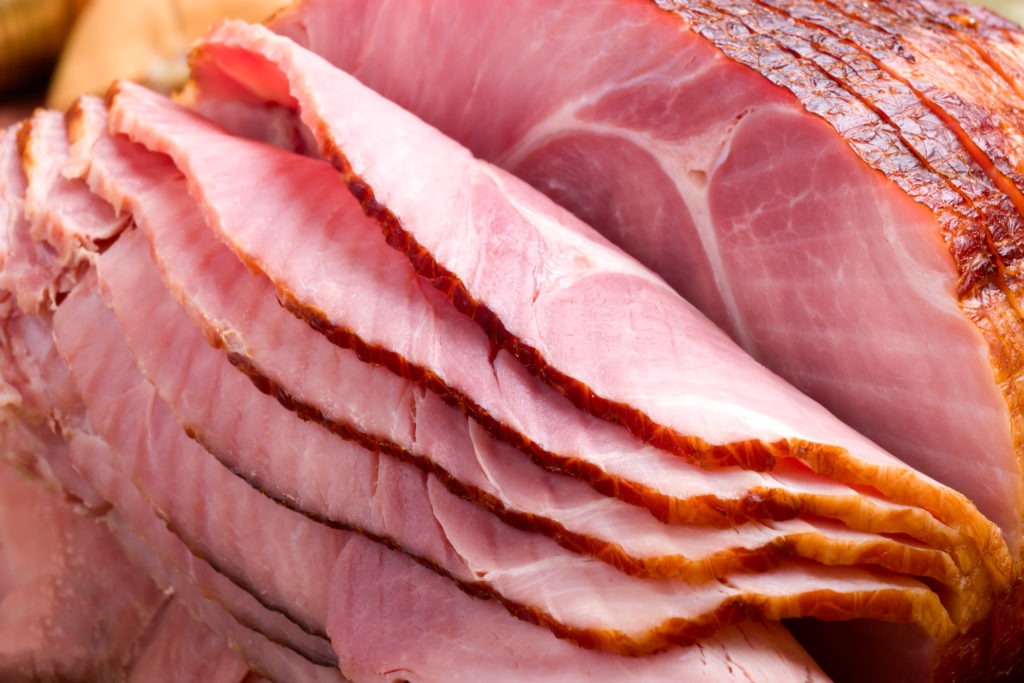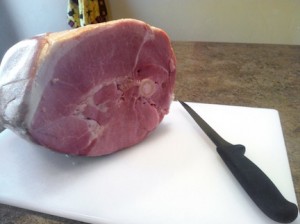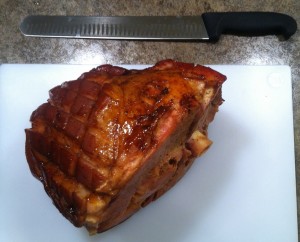Thermal Secrets to Moist and Flavorful Ham
Deciphering between uncooked, cured and ready-to-eat varieties of ham is often an arduous task. And because a mismanaged ham can turn out dry and flavorless, knowing how to prepare each variety will ensure your holiday feast is one to remember.
It’s important to know what kind of ham you’re cooking. Depending on the level to which the ham has been cured (if at all), the cooking process will vary greatly.
[Tweet “Depending on the level to which the ham has been cured (if at all), the cooking process will vary greatly.”]
How to Cook Ham: Know Which Ham to Buy
Fresh Ham
Fresh ham is a raw uncured rear leg of a pig. The cut usually comes with the skin still on. The meat is typically pale pink to beige—the color of raw pork. This type of cut is perfect for roasting, or smoking. Because it hasn’t been cured it’s important that an internal temperature of at least 145°F is reached during the cooking process (per USDA recommended temperatures).
Here’s a great Ham Roast recipe from Cook’s Illustrated. With the right brine, the right sequence of oven temperatures (500 to 350°F), and the right glaze, you can transform an uncured ham into a pork roast with rich, moist meat and crackling crisp skin.

Dry Cured Ham
This type of ham is cured by burying it in a mound of salt or by rubbing the skin with salt. In some cases, sodium nitrite is also added to quell the spread of harmful bacteria and protect the ham during the curing process. It’s usually hung and air-dried for 6-18 months at cool temperatures allowing for dehydration and concentration of flavors. Often a dry cured ham is smoked at low temperatures to help enhance the flavor.
Typically, manufacturers dry-cure ham between 54-74°F. Humidity and air speed are also controlled as growing mold can impede evaporation of water by closing pores on the surface. Cold smoke (<68°F) is applied during the curing process to inhibit the growth of bacteria on the ham surface and prevent mold from growing. It also imparts a different flavor to the final product.
Dry cured hams, like prosciutto and jamon serrano, can be eaten uncooked and at room temperature. You don’t have to worry about foodborne bacteria – the combination of salts and nitrites will have rendered bacteria harmless.
[Tweet “Dry cured hams, like prosciutto and jamon serrano, can be eaten uncooked and at room temperature.”]
Fully Cooked, or Ready-To-Eat

But, roasting a “fully cooked” ham can be tricky. Set your oven too high and you’ll end up with a dry, flavorless ham. Under roast it and you will not have unleashed the hidden flavors, and sufficiently caramelized the glaze.
When it comes to preparing a moist and flavorful ready-to-eat ham, no one does it better than the folks at America’s Test Kitchen (ATK). Their army of chefs have tested several recipes and have come up with one in particular that guarantees to be a family favorite.
[Tweet “When the process of smoking a cured ham raises its internal temperature to 150°F the ham is labeled “fully cooked” or “ready-to-eat.””]
How to Reheat a Fully Cooked Ham
ATK recommends a bone-in spiral sliced ham with natural juices added, rather than “water-added.” Natural juices will produce a more savory and less salty ham.
- To start, soak your ham in a warm water bath (100°F) Be careful not to remove the original packaging before you immerse the ham in water. A water bath will bring the ham up to room temperature (68-72°F) faster than simply letting it sit on the counter. With the internal temperature at, or near room temperature you’ll ensure that (when roasted) heat is distributed evenly throughout, as well as limit the time the ham is exposed to the hot and dry environment of the oven.
- Soak for 45 minutes, then dump and replenish the water and continue to soak for 45 more minutes. After 90 minutes, remove from the water and cut away the original packaging. Move the ham to an oven bag. Using an oven bag will shave time off of the cooking process, and help preserve the juice inside of the ham.
- Place in the bag (cut side down), tie off the top and poke a few holes in the top of the bag. This is an important step! If you forget to poke holes in the bag, it may explode while in the oven.
- Move the ham to a 13×9 inch pan and place in a preheated oven set to 250°F. Roasting at a lower temperature will allow for a more gentle heat transfer that will not squeeze too much moisture out of the meat. Monitor the internal temperature using a leave-in oven probe thermometer. Remove from the oven when the internal temperature reaches 100°F.
- Always verify the temperature of the thermal center of your meat by spot-checking in multiple areas with an instant-read thermometer like the Thermapen® ONE .
- While the ham is heating up, prepare your glaze. Combine 3/4 cup maple syrup, 1/2 cup orange marmalade, 2 TBS unsalted butter, 1/4 TSP cinnamon, 1 TBS dijon mustard and 1 TSP of ground pepper. Mix all of the ingredients in a saucepan and simmer until the mixture reduces by half.
Once you’ve pulled the ham from the oven (100°F), peel down the oven bag and coat with 1/3 of the glaze. Return to the oven (set to 350°F) and let cook for 10 minutes. This last blast of high heat will help to caramelize the glaze and build up a nice crust on the outside of the ham.
- Remove from the oven after 10 minutes, coat with another 1/3 of the glaze then tent with foil and let rest for 30 minutes. The internal temperature should creep up to near 120°F—perfect for serving with your favorite sides and a batch of homemade buttermilk biscuits.
A few tablespoons of the drippings can be mixed with the final 1/3rd of the glaze to make a delicious gravy. Drizzle some over the ham, or enjoy some on a biscuit.
If you’ve got your heart set on a ham from a chain ham store, disregard the recipe above. Honey Baked Hams are made to be enjoyed at room temperature. Any further heating might dry out the meat and ruin a costly dinner. If you really want a warm ham, we believe the ATK method is the best way to heat this ham too. But, we like this brand served according to the processor’s recommendation—room temperature. The company recommends allowing the ham to stand at room temperature one half hour before serving. Up to one hour is probably ok but we recommend that the uneaten portion is refrigerated as soon as possible after the meal.
Buyer’s clubs sell other brands of bargain-priced spiral sliced ham. Instructions included with these hams often advise heating in an oven set to 325°F for 10-12 minutes per pound. Yikes! While there’s no indication of a desired internal temperature, instructions simply dictate that you “not overheat.” Our experience is that simply popping one of these buyer club hams into the oven will leave you with chewy, dried out, separating slices of ham and a pan full of liquid. If the processor’s instructions that come with the ham advise heating, we strongly recommend that you not eat the ham at room temperature. Doing so could be a food safety issue.
However, if your ham is fully cooked and ready-to-eat, we agree with ATK and suggest you ditch the packaged instructions and go with the recipe above. The low-heat process and homemade glaze will trump anything included with the packaging and will guarantee this year’s ham is moist and flavorful.



 Once you’ve pulled the ham from the oven (100°F), peel down the oven bag and coat with 1/3 of the glaze. Return to the oven (set to 350°F) and let cook for 10 minutes. This last blast of high heat will help to caramelize the glaze and build up a nice crust on the outside of the ham.
Once you’ve pulled the ham from the oven (100°F), peel down the oven bag and coat with 1/3 of the glaze. Return to the oven (set to 350°F) and let cook for 10 minutes. This last blast of high heat will help to caramelize the glaze and build up a nice crust on the outside of the ham.
do you have any recommendations of where to buy the best ham? we are having easter at our house and i really want my family and our guests to have a great, almost perfect!, dinner. we have been thru alot these past few months and a great meal will help so much. thank you, now i have to go order one of those oven thermometers!
Hi Rhoda – We picked up our ham at the local grocery store. If you have access to a butcher, give them a try, otherwise the grocer should be fine.
In the recipe for the glaze, it mentions using 2/3 of it. What do we do with the final third? Also, when opening the oven bag and glazing the ham, are we leaving the ham in the juices in the bag? Draining juices? Moving ham to a different pan? It sounds delicious, and I’d like to try it.
Hi Elizabeth – The final 1/3 of the glaze can be mixed with a few tablespoons of the drippings to make a delicious gravy. When opening the bag, we say to peel it back and leave the ham in it. Don’t drain the juice until you’re ready to carve the ham.
Also, before applying the glaze for the first time, are we trimming off the skin?
You should not have to remove the skin. There’s some really good flavor there. We recommend – as does ATK – that you score the skin (lightly) to help get those nice crispy, cracklin’ pieces.
What is the purpose of dumping the water after soaking and replenishing when the ham is sealed in plastic ?
Thanks
To keep the temperature up! After 45 minutes with a cold ham in it, the water will be quite cool. Replenishing the water replenishes the heat.
How long do you think it takes to get the ham to 100 degrees?
After 90 minutes of soaking at 100°F, it should be pretty warm…I’d suppose 45-60 minutes, but it will depend on the size of the ham, etc.
Soaking the ham for 90 min in a warm water bath makes me a bit nervous, from a food safety standpoint. Especially for vacuum sealed foods, as I thought botulism thrives in vacuum sealed foods that are outside the safe temperature zones. Is this not as much of a consideration with the ham because it is cured?
Yes exactly…In fact botulism is a big part of why curing exists in the first place.
After cooked how to kept moist for later
Cover it with foil so the surface won’t dry out.